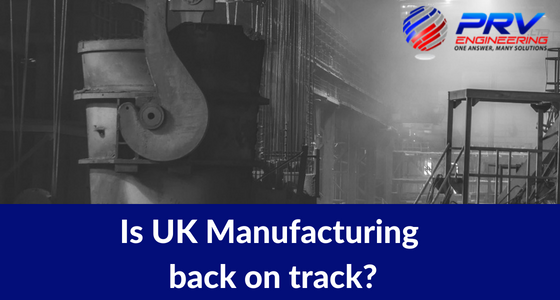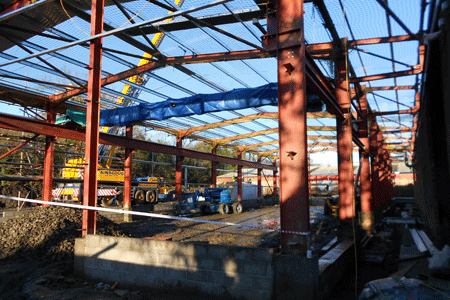The steel industry is a significant contributor to global carbon emissions, accounting for around 7% of all emissions. As such, decarbonising steel production is crucial for achieving global climate goals and reducing the impact of human activity on the environment. There are several ways to decarbonise the steel industry, including the use of alternative raw materials, such as recycled steel and iron ore, as well as the adoption of new technologies and processes that reduce carbon emissions during the steel-making process. In this article, we explore some of the challenges, benefits and processes of decarbonising steel production.
Steel is one of the most common materials, found in almost every industrial sector, from building bridges, factories, and structures to vessels and cars. In construction, the erection of structural steelwork involves the assembly of certain steel components into a frame. The processes include lifting, placing and connecting components which is achieved through bolting or site welding.
The latest monthly CBI Industrial Trends Survey reports that UK Manufacturing output looks promising. They suggest that output has increased strongly and faster since the end of 2017. According to CBI, growth was broad-based, with output increasing in 14 out of 17 sub-sectors. Among the top performers are food, drink and tobacco and mechanical engineering.
Total order books show similar, healthy levels resembling that of December 2017. Exports remained stable, well above average and in line with the past 16 months. Output price expectations for inflation softened to the weakest in almost a year while stock levels moved below average. It hasn’t been smooth sailing as the UK Manufacturing sector faced some serious challenges.
While the CBI believes manufacturers will continue to benefit from robust external demand and the lower exchange rate, overall economic growth is expected to remain subdued. This comes as a result of weak consumer income growth and the continuous uncertainty stemming investments.
Eindhoven in the Netherlands is set to become the center of attention with 3D printed homes. A bridge has already been constructed using cutting edge technology and now, a total of five 3D printed homes will add to the collection. It comes courtesy of a collaboration between the Technical University of Eindhoven, the Eindhoven municipality and several other firms.
Steel pipe and tube manufacturing will restart at Tredegar from next month. The decision from Liberty House, who rescued the site when it went into administration in 2015 forms part of their ‘Greensteel’ strategy and is the seventh steelworks re-opened in as many months.
In its drive the reform the British steel industry the reopened plant will form the latest link in a supply value chain using green energy to upcycle scrap steel from the melting through to the engineering of advanced products.
Hot rolled coil for the plant will come from the rolling mill at Liberty Steel Newport, itself restarted as part of the same plan in October last year.
The UK has one of the highest dependencies on imports of the core product in the developed world and it is hoped that Tredegar’s output will replace some of that one million tonnes of steel currently imported.
This week it’s been announced that Tata Steel could slash up to 1,200 jobs across Scunthorpe and Soctland. Caparo Industries has called in the administrators and now up to 1,700 of their staff are facing real uncertainty about their futures. The UK Steel industry is in crisis and many commentators are rushing to blame China. But the fact of the matter is that the global Steel industry is in crisis, not just the UK, with many nations overproducing and even our closest neighbors in the EU undercutting British produced Steel. At a time when unprecedented trade deals are being fought for and signed across the globe we have to ask if we should still be trying to use China as a scapegoat or if it’s time to reconsider our economic ties with the emergent power.
Although the construction of steel buildings began way back in the 20th century, their use became more widespread during World War II and significantly expanded after the war when steel became more readily available.
Steel buildings have been widely accepted, in part due to cost efficiency. What’s more, the range of application has expanded with improved materials, products and design capabilities and with the availability of computer aided design software.
Here at PRV Engineering we offer a first-class steel framework fabrication and concreting service. Designed as an extension to the services we already provide for the construction industry, and for businesses that are very cost conscious, we believe our new facility is the ideal solution.
What is CE Marking?
CE Marking is the conformity marking for products sold in the European Union and has been a common requirement on things such as toys and electrical goods for many years. It consists of the CE-Logo and, if applicable, the four digit identification number of the notified body involved in the conformity assessment procedure.
What does the CE mark mean?
By affixing the CE mark a person takes on responsibility for the conformity of the product. CE marking is a visible sign that the product complies with all relevant product supply law.Its presence together with the Declaration of Conformity gives the product to which it is affixed presumption of conformity with relevant product safety Directives. CE marked products are entitled to free movement throughout the European market.
The construction industry has gone through one of the most significant changes for a decade this year, when CE Marking of construction products became mandatory in all member states throughout the European Union and the European Economic Area. It’s also preparing itself for further change.
Plasma cutting has been in use since the 1960s. Today it is a widely used metal cutting process. Unlike conventional “metal against metal” cutting, plasma cutting doesn’t produce metal chips so it can create accurate cuts.
Although initially plasma cutting was quite time consuming and expensive, it emerged as a more user-friendly, economical and productive method by the 1980s, due to the application of modern engineering techniques.
Here we discuss the different methods of plasma cutting as well as how it works, applications and pros and cons of utilising it in an engineering application.
Plasma Cutting Processes
First, there are three major processes used for plasma cutting:
Air plasma – In general, a hand-torch is used for metal cutting in this system. It is considered to be the most portable plasma cutting option. In most cases, it uses inverter power supply technology. The important features of this process include:
- The system can run within a power output range of 12 amps to 120 amps
- Cutting thicknesses can be achieved as low as 1/8 inch
Mechanized plasma – This conventional plasma cutting system is extensively used in shipyards, steel service centers and heavy-equipment manufacturing companies in order to obtain high productivity. The notable features of this technique are:
- Uses machine-mountable torches
- Available in amperages ranging from 130 amps to 1,000 amps
- Cutting thicknesses of up to 61⁄4 inches can be achieved
- It requires constant manual monitoring on different factors, such as gas flow, pressure, arc voltage
High definition plasma – This system has emerged as the most viable metal cutting solution in the industry over the last two decades. After its introduction in the 1990s, it went through several research and development processes. High quality cuts, economical operating cost and high cutting speeds are some of the major benefits of using this system. Initially, it had a thickness capacity of 3⁄8 inches. However, with advancements in engineering technology, now cutting thicknesses of up to 3 inches are easily achieved.
Some of the important features of this process are:
- In order to achieve quality in cutting, plasma cutting equires monitoring by expert operators
- Cutting thicknesses can be as low as 26 gauge to as big as 3 inches. When used on carbon steel, thickness capacity of up to 61⁄4 inch is also achievable
- It requires power levels ranging from 130 amps to 800 amps
- Technology updates on plasma cutting methods are continuing to evolve in order to obtain better results in cut quality and productivity
How do you see this kind of technology helping your manufacturing processes in the future? Let us know in the comments below.
- 1
- 2










Recent Comments